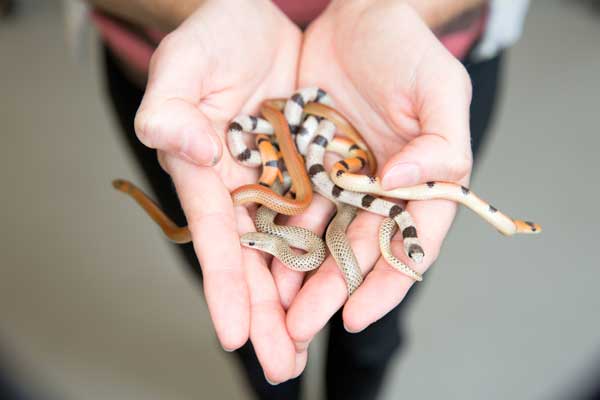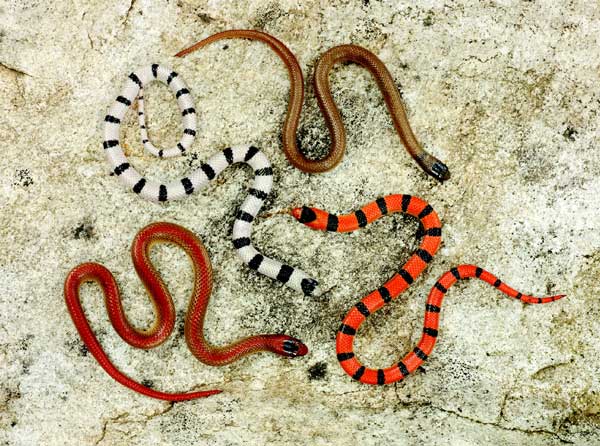Why hasn't evolution eliminated ground snakes that look nothing like coral snakes?
Red on yellow, kill a fellow. Red on black, friend of Jack. Is that folk rhyme still relevant today? According to a new study of non-venomous ground snakes (Sonora semiannulata), the rhyme is still not foolproof due to the fact that coral snakes (Leptomicrurus,Micruroides, and Micrurus), like ground snakes, which mimic the look of certain coral snakes, both display a variety of colors and patterns called color polymorphism. Varying morphs of the coral snake also exist in certain parts of the country where the rhyme doesn't apply, like in Key Largo, Fla. where the yellow skin coloration is absent. But what is more interesting is why evolution hasn't eliminated those ground snakes that don't mimic the coloration of the coral snake. That is the subject of a paper by University of Michigan scientists.

Photo by Eric Bronson.
A close-up showing the different color patterns, which are known as morphs, found in the ground snake.
In their paper titled "Spatial and Temporal Drivers of Phenotypic Diversity in Polymorphic Snakes," published in the current online edition of the American Naturalist, University of Michigan evolutionary biologist Alison Davis Rabosky and her colleague Christian L. Cox determined that ground snakes with rare colorations have advantages over more commonly colored ground snakes. They also found that of the four different colorations of the ground snake that they researched over the course of four years flipping thousands of rocks in areas where the ground snake is native; only one coloration mimic'd the coral snake that is the subject of the rhyme.

Photo by Alison Davis Rabosky.
The four sympatric color morphs of the ground snake (Sonora semiannulata). Clockwise from bottom left: striped morph (S) with red dorsal stripe (bottom left), banded morph (B) with black crosswise bands (top left), uniform morph (U) lacking any distinctive markings (top right), and mimetic morph (M) with both the red stripe and black bands (bottom right).
They collected more than 350 live ground snakes and studied 2,500 specimens in museum collections as well. In studying the changing color patterns in the museum specimens, they found that the snake with the rarest color morph over time became the most common. They attribute this to predators looking for the most common morph coloration and depleting it until it becomes rare, then moving on to what morph coloration is the most common.
Want to Learn More?
"This is what's called a frequency-dependent system, and it makes it hard to lose any of these morphs once they appear," Rabosky said in a news release put out by the university. "The rare morphs have an advantage because they are rare, so gradually their numbers will start to increase again, and the end result is a system with a lot of polymorphism."
The scientists determined that this type of negative frequency-dependent selection is the main reason that ground snakes can be found with multiple color patterns. They also determined that mimicry does in fact change over time and that it is constantly in flux and full of polymorphism.
Ground snakes (Sonora semiannulata) are small snakes that primarily eat insects. They range from southeastern Missouri to northern mainland Mexico to Baja California, Oregon, and southern Idaho. There are three other species in the Sonora genus, all of which mimic the venomous coral snake.


